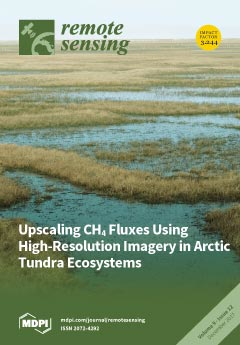The use of Pseudoinvariant Areas (PIA) makes it possible to carry out a reasonably robust and automatic radiometric correction for long time series of remote sensing imagery, as shown in previous studies for large data sets of Landsat MSS, TM, and ETM+ imagery.
[...] Read more.
The use of Pseudoinvariant Areas (PIA) makes it possible to carry out a reasonably robust and automatic radiometric correction for long time series of remote sensing imagery, as shown in previous studies for large data sets of Landsat MSS, TM, and ETM+ imagery. In addition, they can be employed to obtain more coherence among remote sensing data from different sensors. The present work validates the use of PIA for the radiometric correction of pairs of images acquired almost simultaneously (Landsat-7 (ETM+) or Landsat-8 (OLI) and Sentinel-2A (MSI)). Four pairs of images from a region in SW Spain, corresponding to four different dates, together with field spectroradiometry measurements collected at the time of satellite overpass were used to evaluate a PIA-based radiometric correction. The results show a high coherence between sensors (
r2 = 0.964) and excellent correlations to in-situ data for the MiraMon implementation (
r2 > 0.9). Other methodological alternatives, ATCOR3 (ETM+, OLI, MSI), SAC-QGIS (ETM+, OLI, MSI), 6S-LEDAPS (ETM+), 6S-LaSRC (OLI), and Sen2Cor-SNAP (MSI), were also evaluated. Almost all of them, except for SAC-QGIS, provided similar results to the proposed PIA-based approach. Moreover, as the PIA-based approach can be applied to almost any image (even to images lacking of extra atmospheric information), it can also be used to solve the robust integration of data from new platforms, such as Landsat-8 or Sentinel-2, to enrich global data acquired since 1972 in the Landsat program. It thus contributes to the program’s continuity, a goal of great interest for the environmental, scientific, and technical community.
Full article





